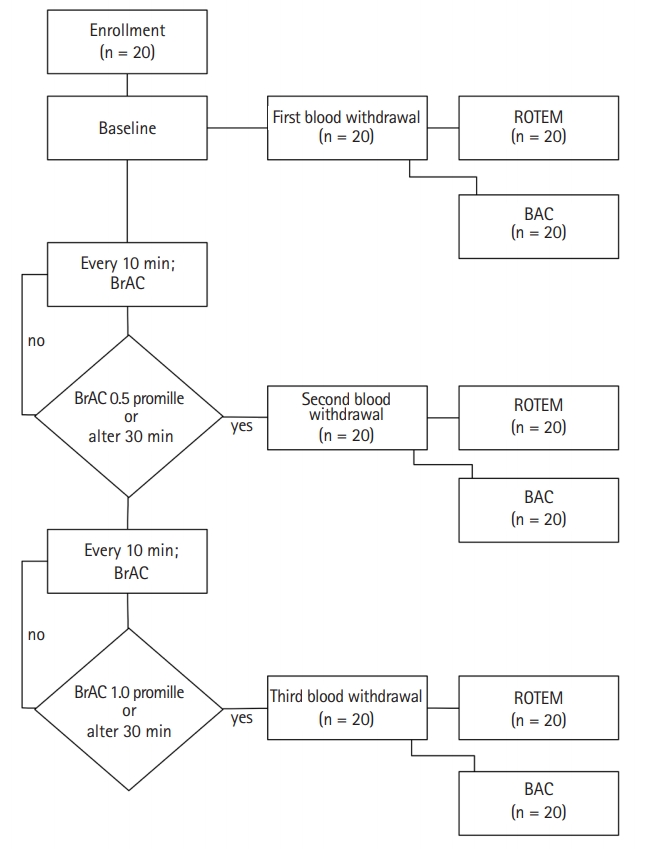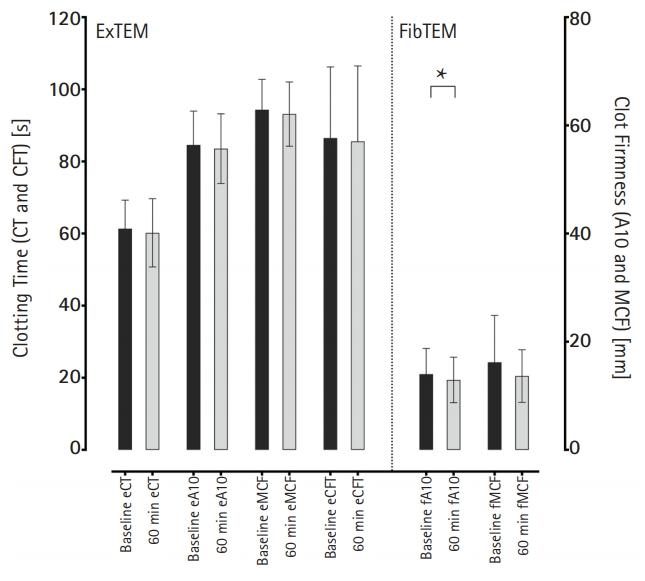 |
 |
| Korean J Anesthesiol > Volume 73(4); 2020 > Article |
|
Abstract
Background
Methods
Results
NOTES
Author Contributions
Hendrik Eismann (Conceptualization; Data curation; Formal analysis; Investigation; Methodology; Writing ŌĆō original draft; Writing ŌĆō review & editing)
Lion Sieg (Conceptualization; Data curation; Formal analysis; Investigation; Methodology; Visualization; Writing ŌĆō original draft; Writing ŌĆō review & editing)
Hala Ahmed (Data curation; Investigation; Writing ŌĆō review & editing)
Joerg Teske (Formal analysis; Investigation; Writing ŌĆō review & editing)
Patrick Behrendt (Formal analysis; Writing ŌĆō review & editing)
Lars Friedrich (Data curation; Writing ŌĆō review & editing)
Carsten Schumacher (Data curation; Investigation; Writing ŌĆō review & editing)
Kai Johanning (Conceptualization; Data curation; Investigation; Methodology; Writing ŌĆō original draft; Writing ŌĆō review & editing)
Fig.┬Ā2.

Fig.┬Ā3.

Table┬Ā1.
Table┬Ā2.
|
Baseline (n = 20) |
30 min (n = 20) |
1 h (n = 20) |
P value* | P valueŌĆĀ | |
|---|---|---|---|---|---|
| BAC (ŌĆ░) | 0 ┬▒ 0 | 0.5 ┬▒ 0.3 | 0.8 ┬▒ 0.2 | <0.001 | 0.002 |
| BrAC (ŌĆ░) | 0 ┬▒ 0 | 0.6 ┬▒ 0.2 | 0.6 ┬▒ 0.2 | <0.001 | 0.002 |
| eCT (s) | 61.4 ┬▒ 7.9 | 62.0 ┬▒ 12.2 | 60.2 ┬▒ 9.5 | 0.608 | 1.000 |
| eA10 (mm) | 56.4 ┬▒ 6.2 | 56.9 ┬▒ 6.2 | 55.7 ┬▒ 6.5 | 0.354 | 1.000 |
| eMCF (mm) | 62.9 ┬▒ 5.6 | 63.0 ┬▒ 5.2 | 62.1 ┬▒ 5.9 | 0.248 | 1.000 |
| eCFT (s) | 86.5 ┬▒ 19.7 | 83.5 ┬▒ 20.5 | 85.6 ┬▒ 21.0 | 0.768 | 1.000 |
| eML (%) | 0.5 ┬▒ 1.1 | 0.2 ┬▒ 0.5 | 0.1 ┬▒ 0.4 | 0.149 | 0.894 |
| fA10 (mm) | 14.0 ┬▒ 4.8 | 13.2 ┬▒ 4.7 | 13.0 ┬▒ 4.2 | 0.014ŌĆĪ | 0.112 |
| fMCF (mm) | 16.2 ┬▒ 8.7 | 13.7 ┬▒ 4.6 | 13.7 ┬▒ 4.9 | 0.075 | 0.525 |
| fML (%) | 1.4 ┬▒ 2.0 | 2.2 ┬▒ 2.5 | 2.1 ┬▒ 2.3 | 0.279 | 1.000 |
Values are presented as mean ┬▒ SD. BAC: blood alcohol concentration, BrAC: breath alcohol concentration, eCT: ExTEM clotting time, eA10: ExTEM amplitude 10 minutes after clotting started, eMCF: ExTEM maximum clot firmness, eCFT: ExTEM clot formation time, eML: ExTEM maximum lysis, fCT: FibTEM clotting time, fA10: FibTEM amplitude 10 minutes after clotting started, fMCF: FibTEM maximum clot firmness, fML: FibTEM maximum lysis,
Table┬Ā3.
|
Baseline |
1 h |
P value* | P valueŌĆĀ | |||
|---|---|---|---|---|---|---|
| Male (n = 11) | ||||||
| ŌĆācCT (s) | 64.7 ┬▒ 5.4 | 63.7 ┬▒ 8.4 | 0.748 | 1.000 | ||
| ŌĆāeA10 (mm) | 55.2 ┬▒ 5.4 | 53.6 ┬▒ 6.0 | 0.190 | 1.000 | ||
| ŌĆāeMCF (mm) | 61.8 ┬▒ 5.3 | 60.2 ┬▒ 5.9 | 0.178 | 1.000 | ||
| ŌĆāeCFT (s) | 90.2 ┬▒ 17.4 | 92.1 ┬▒ 20.2 | 0.688 | 1.000 | ||
| ŌĆāeML (%) | 0.8 ┬▒ 1.3 | 0.2 ┬▒ 0.6 | 0.208 | 1.000 | ||
| ŌĆāfA10 (mm) | 13.4 ┬▒ 4.5 | 11.6 ┬▒ 3.8 | 0.005ŌĆĪ | 0.042ŌĆĪ | ||
| ŌĆāfMCF (mm) | 16.4 ┬▒ 10.8 | 12.1 ┬▒ 4.3 | 0.960 | 1.000 | ||
| ŌĆāfML (%) | 1.7 ┬▒ 2.3 | 2.6 ┬▒ 2.3 | 0.468 | 1.000 | ||
| Female (n = 9) | ||||||
| ŌĆācCT (s) | 57.2 ┬▒ 8.8 | 55.9 ┬▒ 9.4 | 0.706 | 1.000 | ||
| ŌĆāeA10 (mm) | 57.9 ┬▒ 7.1 | 58.2 ┬▒ 6.4 | 0.715 | 1.000 | ||
| ŌĆāeMCF (mm) | 64.2 ┬▒ 6.0 | 64.4 ┬▒ 5.5 | 0.622 | 1.000 | ||
| ŌĆāeCFT (s) | 82.0 ┬▒ 22.4 | 77.6 ┬▒ 20.1 | 0.320 | 1.000 | ||
| ŌĆāeML (%) | 0.1 ┬▒ 0.3 | 0.0 ┬▒ 0.0 | 0.347 | 1.000 | ||
| ŌĆāfA10 (mm) | 14.8 ┬▒ 5.2 | 14.6 ┬▒ 4.3 | 0.681 | 1.000 | ||
| ŌĆāfMCF (mm) | 16.0 ┬▒ 5.6 | 15.6 ┬▒ 5.1 | 0.498 | 1.000 | ||
| ŌĆāfML (%) | 0.9 ┬▒ 1.5 | 1.4 ┬▒ 2.4 | 0.325 | 1.000 |
Values are presented as mean ┬▒ SD. eCT: ExTEM clotting time, eA10: ExTEM amplitude 10 minutes after clotting started, eMCF: ExTEM maximum clot firmness, eCFT: ExTEM clot formation time, eML: ExTEM maximum lysis, fCT: FibTEM clotting time, fA10: FibTEM amplitude 10 minutes after clotting started, fMCF: FibTEM maximum clot firmness, fML: FibTEM maximum lysis,










